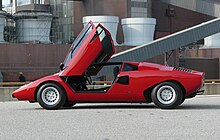Alfa Romeo Carabo
| Alfa Romeo | |
|---|---|

|
|
| Carabo | |
| Presentation year: | 1968 |
| Vehicle fair: | Paris Motor Show |
| Class : | Sports car |
| Body shape : | Coupe |
| Engine: |
Otto engine : 2.0 liters (230 PS) |
| Length: | 4176 mm |
| Width: | 1785 mm |
| Height: | 990 mm |
| Wheelbase: | 2350 mm |
| Empty weight: | 1000 kg |
| Production model: | none |
The Alfa Romeo Carabo (also: Bertone Carabo ) is a concept vehicle designed by Marcello Gandini for the Italian car manufacturer Alfa Romeo , which was presented at the 1968 Paris Motor Show. The sports coupé uses the technology of the Alfa Romeo Tipo 33 . The Carabo is considered to be one of the most influential European design studies of the late 1960s. The innovative features of its body include the pronounced wedge shape and scissor doors that open upwards .
History of origin
In 1966 the racing car Alfa Romeo Tipo 33, designed by Carlo Chiti , made its debut , with which the Alfa subsidiary Autodelta took part in some races of the 1967 World Sports Car Championship . Based on the original design, some further developments appeared in the following years, which were successful up into the 1970s in the sports car world championship , the CanAm series and the Interseries . In 1967, Alfa Romeo derived the road version Tipo 33 Stradale from the racing model , which combined the chassis of the competition vehicle and its 230 hp engine with a coupé body designed by Franco Scaglione . Alfa Romeo struggled to find buyers for the 33 Stradale because of its very high price, the technical complexity and the rounded body, which was felt to be out of date at the time . In the spring of 1968 the company commissioned the Italian design studios Bertone , Italdesign and Pininfarina to design three Stradale- based show cars , which were intended to increase interest in the production model. While the Pininfarina design developed by Leonardo Fioravanti turned out to be very rounded, the bodies by Bertone and Italdesign were emphatically wedge-shaped and more modern by the standards of the time.
The design studios developed the studies at their own expense. Alfa Romeo's contribution was limited to providing the chassis free of charge. Bertone was the first to present his design. It was given the name Carabo, which refers to the family of ground beetles (lat. Carabidae ). Bertone's exhibition copy from 1968 took up their green-orange coloring.
Design of the Carabo
The design of the Carabo comes from Marcello Gandini, who succeeded Giorgetto Giugiaro as Bertone's chief designer in 1966 .
The structure of the Carabo is exceptionally low with a height of 99 cm. What is striking is a wedge-shaped vehicle nose that tapers towards the front, the tip of which is surrounded by a reflective orange stripe. The front section flows smoothly into the steeply sloping A-pillar ; Bertone also spoke of a flush fitted windshield. The B-pillar is at the opposite angle to the A-pillar. The doors form the shape of an uneven hexagon. Behind the doors, the roof line slopes down slightly towards the rear of the vehicle. The rear end forms a spoiler. The engine and the rear window are covered with black plastic slats. The topic is taken up again at the front. Here, too, there are several slats that extend across the width of the car, but they are painted in the same color as the car. When not in use, the slats cover the front twin headlights; when the light is activated, the covers lift slightly. On the flanks in front of the rear wheels on each side there is an angled air inlet that follows the lines of the B-pillar. The doors are hinged in the upper area of the fenders and pivot forward. These so-called scissor doors were first implemented here in an automobile. The entire glazing consists of heat-reflecting glass, which was supplied by the Belgian manufacturer Glaverbel . It shimmers golden or orange depending on the sunlight.
Importance of design
The Alfa Romeo Carabo is seen as an extraordinarily influential show car that changed automotive design forever. Its wedge shape broke with the formal idiom of Italian sports cars that had been in use for two decades, which was characterized by a long bonnet and a short rear end, and gave rise to the sports car design of the 1970s and 1980s.
- The wedge shape, which the Carabo consistently displayed alongside the Bizzarrini Manta ( P 538 ) as one of the first cars, was the model for the design of numerous mid-engine sports cars. Examples are the Ferrari Dino 308 GT 4 (Gandini / Bertone), the Lotus Esprit (Giugiaro / Italdesign) and the Pontiac Fiero .
- The scissor doors were used as standard on the Lamborghini Countach from 1973 and have since been found on its successors Diablo , Murciélago and Aventador . In the meantime they have become a trademark of Lamborghini and are colloquially known as Lambo Doors in the USA .
- Marcello Gandini took on the design of the side air inlets for the Lancia Stratos Zero study (1970). They can also be found in a modified form on the Ferrari Dino 308 GT 4 and the BMW M1 .
- The lamellar cladding of the rear end can be found in the production version of the Lamborghini Urraco and the DeLorean DMC-12 .
- The vehicle profile with the hexagonal doors, the pronounced wedge shape and the lamellar architecture was adopted by the American sports car manufacturer Vector for its small-series cars.
The prototype
Bertone built a prototype of the Carabo within 10 weeks. It was based on chassis no.750.33.109. The ready-to- drive prototype was initially equipped with an original engine from the 33 Stradale .
The first public exhibition of the Carabo took place on the occasion of the Paris Motor Show in October 1968. The Carabo was painted light green at this exhibition. Alfa Romeo and Bertone referred to the car in publications with the masculine grammatical gender as Il Carabo , although automobiles in Italian are regularly in the female gender.
After the exhibition, the Stradale engine was removed at an unknown date , possibly because it was needed as a replacement engine for a production vehicle or as a supplier of spare parts. In its place, Alfa Romeo installed an eight-cylinder Montreal sports car . After an extensive restoration in 1989, the car is in the original color in the Museo storico Alfa Romeo in Arese .
The Carabo remained a one-off. The American Sam Foose, the father of Chip Foose , built a copy of the Carabo on the basis of a De Tomaso Pantera .
literature
- Peter Collins, Ed McDonough: Alfa Romeo Tipo 33: The Development, Racing, and Chassis History , Veloce Publishing Ltd, 2006, ISBN 9781904788713
- Massimo Delbó: Alfa's Triple Whammy . Octane, issue 1/2019 (edition 187), p. 88 ff.
Web links
Individual evidence
- ↑ a b N.N .: Classic Concepts: 1968 Alfa Romeo Carabo. www.classicdriver.com, December 29, 2011, accessed December 27, 2018 .
- ↑ a b c d Peter Collins, Ed McDonough: Alfa Romeo Tipo 33: The Development, Racing, and Chassis History , Veloce Publishing Ltd, 2006, ISBN 9781904788713 , p. 162.
- ↑ a b c Massimo Delbó: Alfa's Triple Whammy . Octane, issue 1/2019 (issue 187), p. 95.
- ↑ a b c Flavien Dachet: Concept Car of the Week: Bertone Alfa Romeo Carabo. www.cardesignnews.com, July 12, 2013, accessed December 27, 2018 .
- ↑ a b c Massimo Delbó: Alfa's Triple Whammy . Octane, issue 1/2019 (issue 187), p. 98.
- ^ Design Museum Enterprise Limited: Fifty Cars that Changed the World , Hachette UK, 2009, ISBN 9781840915853 .
- ↑ Wolfgang Blaube : A fish called Manta . Presentation of the Bizzarrini Manta and a brief description of the history of the Bizzarrini P 538 in: Oldtimer Markt , issue 10/2008, p. 44 ff.
- ↑ See e.g. B. the website of the company Siccor Doors Inc. (accessed on December 27, 2018), which offers kits for converting numerous series vehicles to scissor doors.
- ^ Andrew Evans: Alfa Romeo Carabo: The Wedge That Inspired the Future. www.gtplanet.net, July 6, 2017, accessed December 27, 2018 .
- ↑ The Alfa Romeo Carabo on the website www.nicolaromeoclassic.ch (accessed on December 27, 2018).
- ↑ Illustration of the Foose replica on the website autoweek.com (accessed on December 26, 2018).




